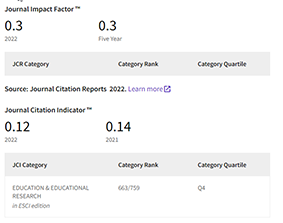On the American expedition of Alexander von Humboldt (1769-1859): connection with nature, nomadic impulse and self-realization
DOI:
https://doi.org/10.14516/ete.2015.002.002.015Palabras clave:
educational history, educational theory, nomadism, open spaces, school visit, natural sciences, Alexander von HumboldtResumen
In this article, the author approaches the figure of Alexander von Humboldt (1769-1859) basically for two reasons. First, he is one of the leading naturalists and geographers of Romanticism, as demonstrated by the following scientific contributions: the organic unity between man and nature, and the vision of nature as a realm of freedom; secondly, his biographical trajectory is quite inspiring from a pedagogical perspective, concerning the scientific expedition he conducted along with the French botanist Aimé Bonpland (1773-1858) through the Americas. Thus, this paper intends to carry out a pedagogical reading of the said journey, divided into the three stages proposed by the same German scientist (preparation, travel and preparation of the work), in order to highlight a number of concepts (nature, nomadism and self-training) as part of different pedagogical worldviews that have occurred throughout the history of education. With this background, this proposed itinerary concludes by emphasizing that one of its possible pedagogical drifts can be an educational practice as well-known as field trips. It is, therefore, a study that has been carried out through the hermeneutics of the main texts of Humboldt and others from natural science and, of course, of pedagogy.
Referencias
AA. VV. (2005). Alejandro de Humboldt. Una nueva visión del mundo. Madrid: Museo Nacional de Ciencias Naturales (Consejo Superior de Investigaciones Científicas).
Beck, H. (1971). Alexander von Humboldt. México DF: Fondo de Cultura Económica.
Bollnow, O. F. (1969). Hombre y espacio. Barcelona: Labor.
Eckermann, J. P. (2000). Conversaciones con Goethe. México DF: Conaculta y Océano.
Fernández, J., Holl, F. (2002). El mundo de Alexander von Humboldt: antología de textos. Madrid: Real Jardín Botánico, Lunweg Editores.
Ferrer Guàrdia, F. (2010). La escuela moderna. Madrid: Biblioteca Nueva.
Freinet, C. (1976). Técnicas Freinet de la escuela moderna. México DF: Siglo veintiuno editores SA.
Fröbel, F. (1913). La educación del hombre. Madrid: Daniel Jorro.
Gadamer, H. G. (2012). Verdad y método. Salamanca: Sígueme.
Gómez de la Serna, G. (1974). Los viajeros de la Ilustración. Madrid: Alianza Editorial SA.
Heidegger, M. (2003). Observaciones relativas al arte – la plástica – el espacio. El arte y el espacio. Pamplona: Universidad Pública de Navarra.
Hesse, H. (1978). El caminante. Barcelona: Editorial Bruguera SA.
Humboldt, A. von. (1960a). Ensayo político sobre la isla de Cuba. La Habana: Publicaciones del Archivo nacional de Cuba.
Humboldt, A. von. (1960b). Breve relación del viaje. En CSIC, Alejandro de Humboldt. Una nueva visión del mundo (pp. 155-157). Madrid: Museo Nacional de Ciencias Naturales (Consejo Superior de Investigaciones Científicas).
Humboldt, A. von. (1961). Cuadros de la naturaleza. Barcelona: Editorial Iberia SA.
Humboldt, A. von. (1980). Cartas americanas. Caracas: Biblioteca Ayacucho.
Humboldt, A. von. (1981). Del Orinoco al Amazonas. Barcelona: Editorial Labor SA.
Humboldt, A. (1991). Viaje a las Regiones Equinocciales del Nuevo Continente. Tomo I. Caracas: Monte Ávila Editores.
Humboldt, A. von. (2005). La travesía de La Habana a Filadelfia. En CSIC, Alejandro de Humboldt. Una nueva visión del mundo (pp. 155-157). Madrid: Museo Nacional de Ciencias Naturales (Consejo Superior de Investigaciones Científicas).
Humboldt, A. von. (2011). Cosmos. Ensayo de una descripción física del mundo. Madrid: Los libros de la Catarata, Consejo Superior de Investigaciones Científicas. Doi:
Ipland, J. (1998). El concepto de «bildung» en el neohumanismo alemán. Huelva: Hergué Editorial.
Maciques, E. (1999). Alexander von Humboldt en Cuba (1769-1859). Revista Hispano Cubana, 3, pp. 89-97.
Maffesoli, M. (2004). El nomadismo. Vagabundeos iniciáticos. México: Fondo de Cultura Económica.
Planella, J. (2004). Cos i discursivitat pedagògica: bases per a la ideació corporal (Tesis doctoral). Universidad de Barcelona, Barcelona.
Puig-Samper, M. A., Rebok, S. (2007). Sentir y medir. Alexander Von Humboldt en España. Aranjez: Doce calles SL.
Quintana, J. M.ª (1995). Teoría de la Educación: Concepción antinómica de la Educación. Madrid: Dykinson.
Tolstoi, L. (1978). La escuela de Yasnaia Poliana. Barcelona: Pequeña Biblioteca Calamus Scriptorius.
Tusquets, J. (1983-84). El sedentarisme pedagògic a Catalunya. Boletín de la Real Academia de Buenas Letras, 39, pp. 83-92. Recuperado el 24 de abril de 2015, de
Tusquets, J. (1981-1982). El nomadisme pedagògic a Catalunya. Boletín de la Real Academia de Buenas Letras, 38, pp. 207-223. Recuperado el 24 de abril de 2015, de
Vilanou, C. (2001). De la ‘Bildung’ a la Pedagogía Hermanéutica. Ars Brevis, 7, pp. 255-279.
Vilanou, C. (2011). La Pedagogía alemana y su recepción en España: la idea de formación y las Ciencias del Espíritu. En Hernández, J. Mª (Ed.), La pedagogía alemana en España e Iberoamérica (1810-2010) (pp. 136-191). Valladolid: Castilla Ediciones.







